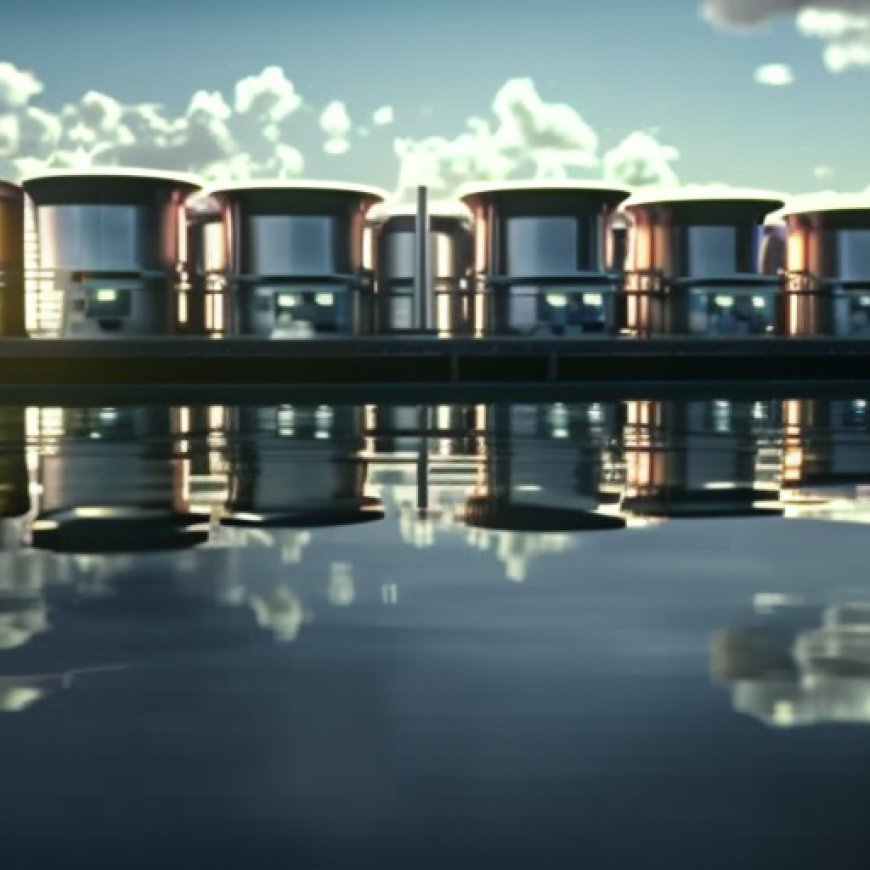U.S. Water and Wastewater Treatment Technologies Market Worth $24.63 Billion by 2029
U.S. Water and Wastewater Treatment Technologies Market Worth ... Digital Journal


U.S. Water and Wastewater Treatment Technologies Market
Published September 18, 2023
The U.S. water and wastewater treatment technologies market is expected to grow at a CAGR of 5% from 2020–2029 to reach $24.63 Billion by 2029, according to a new market research report titled “U.S. Water and Wastewater Treatment Technologies Market” published by Meticulous Research®.
Sustainable Development Goals (SDGs)
- Goal 6: Clean Water and Sanitation
- Goal 9: Industry, Innovation, and Infrastructure
- Goal 11: Sustainable Cities and Communities
- Goal 12: Responsible Consumption and Production
Introduction
In the U.S., water and wastewater treatment systems are used in various applications such as residential, commercial, agricultural, municipal, institutional, industrial, utility, brewery, winery, and distillery. The growth of the water and wastewater treatment technologies market in the U.S. is influenced by factors such as innovative research, focus on water pollution abatement, techno-economic networks, water reclamation and reuse technologies, increased water pollution, and establishment of new manufacturing plants. Additionally, stringent regulations on onsite wastewater treatment systems (OWTS), improvements in wastewater treatment technology, and the increasing prevalence of waterborne diseases drive the market growth.
Market Opportunities and Challenges
The growing demand for energy-efficient and advanced water treatment technologies provides significant growth opportunities for vendors in the U.S. water and wastewater treatment technologies market. However, high installation, maintenance, and operational costs hinder market growth to a notable extent. Additionally, the aging and deterioration of existing water infrastructure pose major challenges for the market.
Market Segmentation
Treatment Technology Type
- Membrane Separation & Filtration
- Reverse Osmosis (RO) Membranes
- Ultrafiltration (UF) Membranes
- Microfiltration (MF) Membranes
- Nanofiltration (NF) Membranes
- Other Filtration Technologies
- Sludge Management Technology
- Activated Sludge
- Clarification
- Chlorination
- Industrial Demineralization
- Membrane Bioreactor (MBR)
- UV And Ozone
- Dissolved Air Flotation
- Electrochemical Scale Treatment Systems
- Electrochemical Water Treatment Technology (Electrocoagulation and Electro-oxidation–EEC/EEO)
- Other Treatment Technologies
Application
- Municipal
- Industrial
- Food & Beverages
- Pharmaceuticals and Chemicals
- Power Generation
- Pulp and Paper
- Oil & Gas
- Mining
- Petrochemical
- Semiconductors
- Other Industrial Applications
Key Players
The key players operating in the U.S. water and wastewater treatment technologies market include Suez Environnement S.A., Veolia Environnement SA., Xylem, Inc., DuPont de Nemours, Inc., 3M Company, Inc., Pentair plc, Kurita Water Industries Ltd., Bio-Microbics, Inc., Calgon Carbon Corporation, Trojan Technologies Inc., Ecolab, Inc., GFL Environmental Inc., and Clean TeQ Water Limited among others.
Contact Information
Contact: Mr. Khushal Bombe
Meticulous Market Research Inc.
1267 Willis St, Ste 200 Redding,
California, 96001, U.S.
USA: +1-646-781-8004
Europe: +44-203-868-8738
APAC: +91 744-7780008
Email: [email protected]
Website: https://www.meticulousresearch.com/
LinkedIn: https://www.linkedin.com/company/meticulous-research
SDGs, Targets, and Indicators Analysis
1. Which SDGs are addressed or connected to the issues highlighted in the article?
- SDG 6: Clean Water and Sanitation
- SDG 9: Industry, Innovation, and Infrastructure
- SDG 11: Sustainable Cities and Communities
- SDG 12: Responsible Consumption and Production
- SDG 13: Climate Action
The article discusses the U.S. water and wastewater treatment technologies market, which is directly related to SDG 6 (Clean Water and Sanitation). It also mentions the growing focus on water pollution abatement, which connects to SDG 9 (Industry, Innovation, and Infrastructure). The article further highlights the need for water reclamation and reuse technologies, which aligns with SDG 11 (Sustainable Cities and Communities). Additionally, the emphasis on reducing the usage of chemicals in water treatment relates to SDG 12 (Responsible Consumption and Production). Lastly, the mention of waterborne diseases and the need for wastewater treatment technology connects to SDG 13 (Climate Action).
2. What specific targets under those SDGs can be identified based on the article’s content?
- Target 6.3: Improve water quality by reducing pollution, eliminating dumping, and minimizing release of hazardous chemicals.
- Target 9.4: Upgrade infrastructure and retrofit industries to make them sustainable.
- Target 11.6: Reduce the adverse environmental impact of cities, including air quality, waste management, and water quality.
- Target 12.4: Achieve environmentally sound management of chemicals and all wastes throughout their life cycle.
- Target 13.2: Integrate climate change measures into national policies, strategies, and planning.
Based on the issues discussed in the article, these specific targets can be identified. The article mentions the need for reducing water pollution and minimizing the release of hazardous chemicals, which aligns with Target 6.3. The emphasis on sustainable infrastructure and reducing environmental impact connects to Target 9.4 and Target 11.6, respectively. The mention of reducing chemical usage in water treatment relates to Target 12.4. Lastly, the need to address waterborne diseases and wastewater treatment aligns with Target 13.2.
3. Are there any indicators mentioned or implied in the article that can be used to measure progress towards the identified targets?
- Indicator 6.3.2: Proportion of bodies of water with good ambient water quality.
- Indicator 9.4.1: CO2 emission per unit of value added.
- Indicator 11.6.1: Proportion of urban solid waste regularly collected and with adequate final discharge out of total urban solid waste generated.
- Indicator 12.4.1: Number of parties to international multilateral environmental agreements on hazardous waste.
- Indicator 13.2.1: Number of countries that have integrated mitigation, adaptation, impact reduction, and early warning measures into national policies, strategies, and planning.
The article does not explicitly mention these indicators, but they can be used to measure progress towards the identified targets. These indicators focus on measuring the proportion of bodies of water with good water quality (Indicator 6.3.2), CO2 emissions per unit of value added (Indicator 9.4.1), proportion of urban solid waste with adequate final discharge (Indicator 11.6.1), number of parties to environmental agreements on hazardous waste (Indicator 12.4.1), and integration of climate change measures into national policies (Indicator 13.2.1).
Table: SDGs, Targets, and Indicators
| SDGs | Targets | Indicators |
|---|---|---|
| SDG 6: Clean Water and Sanitation | Target 6.3: Improve water quality by reducing pollution, eliminating dumping, and minimizing release of hazardous chemicals. | Indicator 6.3.2: Proportion of bodies of water with good ambient water quality. |
| SDG 9: Industry, Innovation, and Infrastructure | Target 9.4: Upgrade infrastructure and retrofit industries to make them sustainable. | Indicator 9.4.1: CO2 emission per unit of value added. |
| SDG 11: Sustainable Cities and Communities | Target 11.6: Reduce the adverse environmental impact of cities, including air quality, waste management, and water quality. | Indicator 11.6.1: Proportion of urban solid waste regularly collected and with adequate final discharge out of total urban solid waste generated. |
| SDG 12: Responsible Consumption and Production | Target 12.4: Achieve environmentally sound management of chemicals and all wastes throughout their life cycle. | Indicator 12.4.1: Number of parties to international multilateral environmental agreements on hazardous waste. |
| SDG 13: Climate Action | Target 13.2: Integrate climate change measures into national policies, strategies, and planning. | Indicator 13.2.1: Number of countries that have integrated mitigation, adaptation, impact reduction, and early warning measures into national policies, strategies, and planning. |
Behold! This splendid article springs forth from the wellspring of knowledge, shaped by a wondrous proprietary AI technology that delved into a vast ocean of data, illuminating the path towards the Sustainable Development Goals. Remember that all rights are reserved by SDG Investors LLC, empowering us to champion progress together.
Source: digitaljournal.com

Join us, as fellow seekers of change, on a transformative journey at https://sdgtalks.ai/welcome, where you can become a member and actively contribute to shaping a brighter future.







